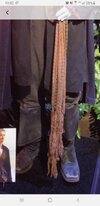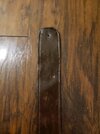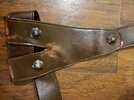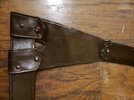Because I seem to have mastered the art of not following a straight thought process, I have some catch up posting to do today. First, the construction of the animal print (tortoise/turtle most likely but has been suggested to be choice sections of croc/al without the spikes) belt. Previous post, from Oct 15, shows the creation of the embossed pattern face. Let's just agree now that there were things that should have been done differently and I hope this can save you some headache on yours. First mistake, I used vinyl instead of leather. Just don't. Leather would have been so much easier to emboss, color and weather/age. Second error, I made this belt in four separate strips when it needed only 2, a front and a back. I made the piping as a separate strip on both edges because I had it in my head to make piping like for furniture. This means I cannot provide the width you need to do the leather as it would just be the front folding onto the back (as my baldric did on post Sept 26) but with enough space in the fold for 3/16 inch piping cord.
Mine was two side strips sewn face to face with the front pattern side at the edges (one per edge). Then unfolded and wrapped completely around the back to cover the edges of the back face while wrapping around my cordage edging. My vinyl had a cloth back. Keep this in mind when viewing the pictures, cloth means back in this belt process. This first pic shows two stages, before sewing and after the edges are turned out. The second picture shows stage three, sewing this 3 piece front onto the back layer.
In that picture the vinyl sides are facing out. No cloth faces are showing.
(Update 10/30/22 Heads Up: In the following sentence I describe some trimming that should not have been done at this point. You will see why, a few sentences later)
Because of doing this 4 piece method, there was a lot of excess width that was needed for the sewing machine and then trimmed off before wrapping the edges onto the back face. The piping edge strips started at 1 and 3/4 inch wide. The front pattern face was 2 and 3/4 inch. After sewing the piping edges to the pattern face at the edges, two strips on opposite edges, I trimmed 5/16 off both edges. This left the Patterned face at 2 and 1/8 wide with the seam just inside the cut edge (about 1/8 inch). Using fabric adhesive, I adhered the front (cloth backside) to the back (also the cloth backside). In sewing terms, this is wrongside to wrongside. The back face vinyl did not have a pattern, in order to match the movie. This back of the belt shows prominently in most scenes. The back face width was 2 and 1/4 inches so when aligning the two pieces, centered to each other, it will have a protruding edge on both edges. About 1/16.
This is the hard part. Folding the front edging flaps all the way around to the back (with piping inserted) turned out to be too difficult and I was forced to sew it first and then insert the cord.... not fun. Had I started with an edging width plus another half inch on each edge, I could have sewn the piping in during the last step. The sewing machine must have this extra width or it will attempt to eat the edge and jam the machine.
(you saw that right? I needed the extra distance I trimmed off moments before..... So ya, don't trim the two side strips (piping) until the entire belt is finished)
When the front flaps are folded back they reveal the seam. Using a method referred to as Stitch in the ditch, you will now sew the front to the back through this seam which will now contain 3 layers, front seam, back face and folded edge of the piping piece. See image above of rolled edge. If you make the same mistake I did or otherwise cannot put your cording inside the piping flaps during sewing, MAKE SURE TO LEAVE THE EXTRA FOR PUTTING IN THE CORD AFTER. It should leave a big loop on both edges to put in the cord.
When done, you can trim the back of the belt in any areas that are not straight on the excess folded cloth past the seam.
I finished the buckle end with the four holes and prong slot as was done on the belt from the baldric (Oct 17 post).
Also, when painting, remember the back is solid dark brown heading to black, even the piping edge. Paint all fasteners to hide them, no shining chrome allowed.
And my defacto excuse, this is not replica quality as a single piece. My goal is to be near screen match on the portion the camera will see. This is not original match hardware in the fasteners.







